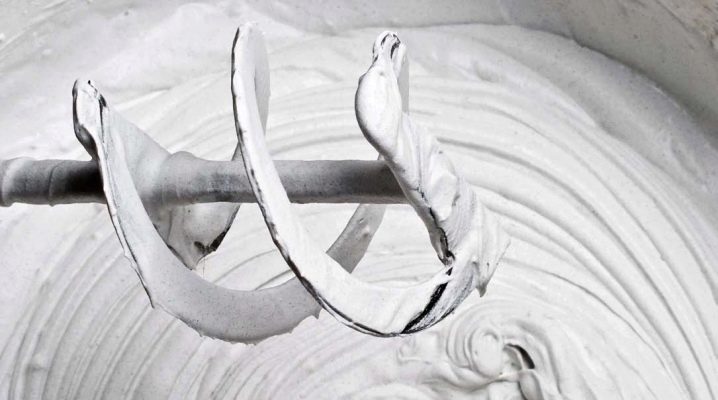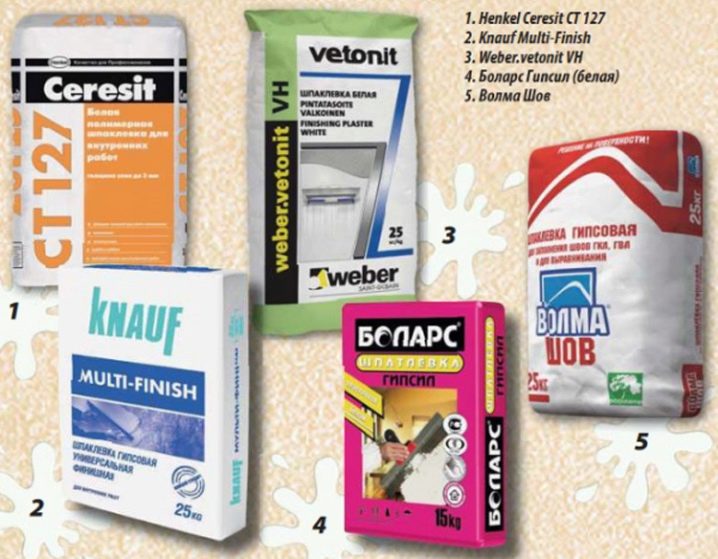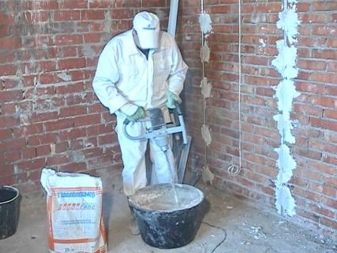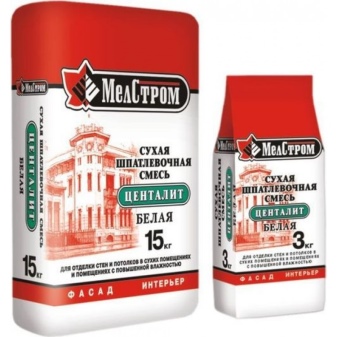How to properly dilute the wall putty?

The question of how to dilute the putty is often asked by people who decide to make repairs on their own. Puttying is one of the important preparatory stages, on which the quality of the final result depends. Not everyone can afford ready-made compositions, therefore, a huge selection of dry powders is offered on the construction markets, which, if the correct dilution ratios are observed, can become a worthy alternative to expensive ones. It is about how to properly dilute the putty mixture for walls at home, and will be discussed in this article.

Peculiarities
Dry putty mixture is a powdery material, which includes binders, the main filler and various additives. Before applying to the wall to be leveled, it should be diluted with water in the ratio indicated on the packaging by the manufacturer.

Dry putty has a number of undeniable advantages:
- long service life;
- resistance to different temperatures (can be stored in both warm and cold rooms);
- the ability to control the consistency;
- low cost;
- ease of use;
- ease of transportation.

The prepared solution cannot be used:
- with high humidity, as over time it will begin to peel off the walls;
- with sudden changes in temperature, which will quickly lead to its softening.

Experts recommend diluting and mixing the putty with a drill with a special mixing nozzle. With its help, the mass turns out to be more homogeneous than when using improvised means.
How to choose?
When buying a dry putty mixture, you should pay attention to the following points:
- safety - the composition should include only substances harmless to human health;
- adhesion - adhesion to the surface to be leveled must be good;
- convergence - the formation of a smooth surface should occur without the use of additional tools and materials;
- resistance to external influences;
- the possibility of grinding.

In addition, when choosing, you need to decide at what stage of finishing you plan to use a leveling coating.
Depending on the purpose, the plaster is of the following types:
- Basic (starting). She is given the entire rough-relief surface treatment: they correct irregularities, close up cracks, fill in depressions. Such a composition is applied with a layer up to 7-8 mm thick. If the flaws cannot be eliminated the first time, then the layer is reapplied. After this initial leveling, the surface is flat and slightly rough due to the coarse-grained components of the putty.
- Finish. It is intended for finishing the surface and bringing it to a perfectly smooth state. It is applied once with a thin layer on a pre-dried starting putty.
- Universal. It is used for both roughing and finishing work, but it is distinguished by its increased cost and not always the required efficiency.

The main component of the mixture plays an important role in where and under what conditions it will be used.
Depending on the composition, the putty is of the following types:
- Cement. It is used for finishing the facades of buildings, as well as damp and unheated rooms: bathrooms, kitchens, swimming pools, basements. It is moisture resistant and resistant to extreme temperatures.After being applied to the wall, such a putty begins to shrink strongly, as a result of which the layers of solution have to be reapplied for better alignment. Its curing speed is low and amounts to 28-30 days, which significantly slows down the finishing process.


- Plaster. Designed for dry rooms inside the building: living room, bedroom, corridor. In this case, the solution dries on the surface within a few days, but it also quickly decomposes under the influence of moisture.
- Polymeric. It is a universal mortar for leveling polyurethane, cement, concrete and plaster surfaces. It combines the properties of cement and gypsum plaster, resulting in a high cost.


- Oil and glue. It is applied before painting on concrete, wood and plastered surfaces.
- Water-dispersive. It is used for partial leveling of bases made of various materials: wood, aerated concrete, brick.
- Polyester. It is used when working on metal, wood, paintwork, concrete, natural stone. It is successfully used to seal holes and through holes, get rid of rust and corrosion. This composition is distinguished by good adhesion, increased strength and water resistance.


Proportions
The diluted putty solution should have a characteristic consistency and density. To achieve this, it is necessary to maintain the correct ratio of water to dry matter. For each species, these proportions are different.
Gypsum-based compositions are diluted in a ratio of 1: 0.8, that is, 0.8 liters of liquid is required per 1 kg. For cement compositions, water will be required 2 times less: 0.37-0.42 liters per 1 kg. 1 kg of polymer putty is diluted with 0.25 liters of liquid.


Depending on the situation, the water flow can be changed. So, with a basic finish, a thicker composition is required, so less liquid is allowed to be used. For decorative finishing, a liquid mixture is used, respectively, more water will be required.

Please note that dilution water must be taken at room temperature.
Process technology
The process of making a mixture at home should begin with the preparation of the necessary tools.
You will need:
- capacious bucket with high walls without rounded corners (plastic, enameled or galvanized);
- drill with attachment;
- scales;
- paint brush or spatula.

To correctly make the putty with your own hands, you should adhere to the following procedure:
- We fill the bucket with the required amount of water.
- Shake it in a circular motion to wet the remaining dry walls of the container.
- Weigh the dry mixture and carefully pour it into the water. Then we leave for 3-5 minutes so that it becomes slightly sour.
- We slowly immerse the drill and begin to mix the solution by moving the mixing nozzle in a circle, right-left, up and down.

- Having achieved the desired consistency, we stop the batch. We clean the adhering remains of the mixture from the walls of the bucket with a spatula or brush. We repeat the batch.
- We do not touch the prepared mass for 10-15 minutes, we give it time to swell.
- Add 1 tbsp. l. PVA glue, which will make the solution softer and more elastic, and the layer applied to the surface is stronger and more reliable.
- We repeat the batch.
- We take out the drill, put it in another container with water and run it for 1-2 minutes. In this way, dirt from the nozzle is instantly removed.

If you do not have a mixer available, the mixture can be mixed by hand. Pour dry putty powder into the dried bucket and then gradually pour in water. We knead in a circular motion, gradually moving from the center to the edges. If the solution has a too liquid consistency, then more mixtures are added to it, if too thick - more water.
Please note that in this case, putty is poured first, and not liquid is poured. If you do the opposite, as with mechanical mixing, lumps will appear in the composition, which will be difficult to get rid of.

The above method is suitable for cement and polymer based formulations.
Dilution of gypsum putty is done in a slightly different way:
- Pour 7 trowels of powder into a bucket and fill them with the same volume of liquid. Mix everything thoroughly;
- Add the remaining parts of the mixture and water and mix everything until smooth;
- Leave the solution for 2-3 minutes to swell and mix everything again.


Unlike other types, gypsum plaster is very capricious. After drying, it can crack over time due to a number of reasons: violation of production technology, non-observance of the correct proportions of components, a thin layer of application (less than 5 mm), dirty surface to be treated.

The stages of diluting putty with fiberglass are not particularly difficult.
In this case, you should adhere to the following sequence of actions:
- Move to a warm room. The temperature on the thermometer should not be lower than 18 and not higher than 25 degrees Celsius.
- After opening the jar with the composition, mix it thoroughly so that the solvent rises up.
- Prepare a clean container and pour out some of the mixture that you need for work, and cover the rest with a lid. Since the diluted composition dries instantly, dilute it as much as you can work out in 10 minutes.
- Add hardener.
- Stir everything with a spatula. The composition should be thick and homogeneous.


As a rule, such well-known companies as Novol, Sea-Line, QuickLine indicate on the packaging the correct dilution proportions of the putty with the hardener. If the manufacturer did not mention this, then the masters recommend using electronic scales of increased accuracy or your own eye. The amount of hardener should be equal to 3% of the total filler mass.

This ratio can be determined in the following simple way:
- We collect the mixture from the container with a spatula and immediately transfer it to another spatula.
- Divide the mass in half. In each part, 50% remains.
- We divide one of the parts in the same way again. It turns out 25%.
- We repeat the procedure. It turns out 12%.
- The resulting slide is evenly divided into 4 parts, thereby obtaining the required 3% of the hardener.

It is very important to observe the correct proportions when mixing: if you add too much hardener, its excess will not interact with the particles of the putty composition, as a result of which, after application, streaks and stains will appear on the treated surface. If there is not enough hardener, the solution will turn out to be watery, it will be difficult to apply to the base and will harden unevenly.

Helpful hints and tips
When working with putty, experts recommend adhering to the following rules:
- Mix the mixture gradually. Start at a low speed, slowly increasing the revs. Doing so will help prevent lumps and bubbles from appearing.
- After mixing, let the solution sit for a few minutes and then stir it again. Thus, the constituent components will adhere better.
- Use only clean containers and tools. The combination of particles of the old and new mixture will lead to a violation of the consistency and elasticity of the future composition, which will adversely affect the quality of the finish.

- Do not apply a large amount of putty at once, otherwise it will quickly dry out and set in lumps. If, out of inexperience, you have diluted a whole pack with water, then leave a quarter of the mass for further work, and pour the rest into a thick-walled container and close it tightly with a lid to avoid drying out.
- When buying, check the expiration date of the putty. Mixtures with an expired date of sale set quickly, smear poorly on the surface and stick to the spatula, which complicates the work and affects the durability of the finish.
- Purchase mixtures at specialized hardware stores or hypermarkets.


- Combine blends from different companies.If you do not have the opportunity to buy many packs of expensive putty, then it is allowed to mix it with a lower cost one. Thus, you can get a better base for finishing.
- Place the washed mixer only upside down. Otherwise, drops of water or residual solution will fall under the cartridge, as a result of which it will quickly rust.
- Use only soft, lint-free cloths to remove excess moisture from tools.

For video instructions on how to dilute the putty, see below.













The comment was sent successfully.